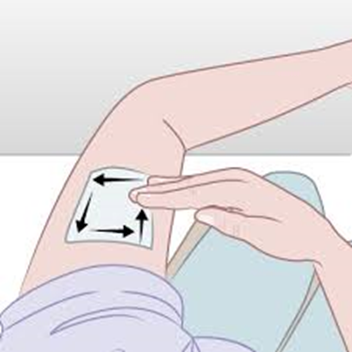A nurse is preparing to administer subcutaneous enoxaparin. In which order should the nurse perform the following steps? (Move the steps into the box on the right, placing them in the order of performance. Use all the steps.)
Locate the injection site 5 cm (2 in) to the right or left of the umbilicus.
Check the medication administration record to verify the client's allergies.
Slowly inject the medication into the site without aspirating.
Pinch clean skin at the injection site and dart the needle into the skinfold at a 90° angle.
Ensure an air bubble is present in the prefilled enoxaparin syringe.
The Correct Answer is B, E, A, D, C
B. Check the medication administration record to verify the client's allergies. Before preparing or administering any medication, the nurse must verify the client’s medication order and allergies to ensure safety. E. Ensure an air bubble is present in the prefilled enoxaparin syringe. The prefilled syringe contains an air bubble that should remain to ensure the entire dose is administered and to prevent medication from tracking back through the tissue. A. Locate the injection site 5 cm (2 in) to the right or left of the umbilicus. Enoxaparin should be administered in the subcutaneous tissue of the abdomen, avoiding areas near the umbilicus to reduce the risk of irritation and bruising. D. Pinch clean skin at the injection site and dart the needle into the skinfold at a 90° angle. Pinching the skin ensures the medication is delivered into the subcutaneous tissue, and injecting at a 90° angle minimizes pain and ensures proper technique. C. Slowly inject the medication into the site without aspirating. Aspiration is not necessary for subcutaneous injections. Slowly injecting reduces discomfort and ensures proper absorption.
Nursing Test Bank
Naxlex Comprehensive Predictor Exams
Related Questions
Correct Answer is C
Explanation
Choice A Reason:
Informing the client of the adverse effect of diarrhea is less common with clonidine use, especially in comparison to other side effects like dry mouth or skin irritation.
Choice B Reason:
Monitoring for weight loss isn't a primary concern specifically associated with transdermal clonidine use.
Choice C Reason:
Advise the client about increased dry mouth. Dry mouth is a common adverse effect of clonidine, including the transdermal form. Patients should be informed about this so they can manage it effectively, for example, by drinking plenty of water or using sugar-free gum or candy to stimulate saliva production.
Choice D Reason:
Hypopigmentation is not a commonly reported issue with transdermal clonidine patches. However, local skin irritation or rash can occur at the site of the patch.

Correct Answer is D
Explanation
Choice A Reason:
"I wish my sexual relationship with my partner was like it was before." This statement indicates a desire to return to the previous state, implying a sense of dissatisfaction or longing for the way things were before the ileostomy surgery, rather than acceptance of the current situation.
Choice B Reason:
"I have my partner empty the bag for me, so I don't have to look at it."While having a partner assist with bag management might indicate some level of adaptation, the statement implies avoidance or discomfort in dealing directly with the ileostomy. It may suggest a lack of full acceptance or adjustment to the presence of the ileostomy.
Choice C Reason:
“I look forward to having normal bowel movements again." This statement expresses a desire to return to the previous bodily function, indicating a longing for the way things were before the surgery rather than complete acceptance of the ileostomy as a new way of managing bowel movements.
Choice D Reason:
"I will attend a support group to help me handle difficulties when they occur." Attending a support group demonstrates a proactive approach toward acceptance and adjustment to living with an ileostomy. It shows the client's willingness to seek support, learn coping strategies, and engage with others facing similar challenges.

Whether you are a student looking to ace your exams or a practicing nurse seeking to enhance your expertise , our nursing education contents will empower you with the confidence and competence to make a difference in the lives of patients and become a respected leader in the healthcare field.
Visit Naxlex, invest in your future and unlock endless possibilities with our unparalleled nursing education contents today
Report Wrong Answer on the Current Question
Do you disagree with the answer? If yes, what is your expected answer? Explain.
Kindly be descriptive with the issue you are facing.
